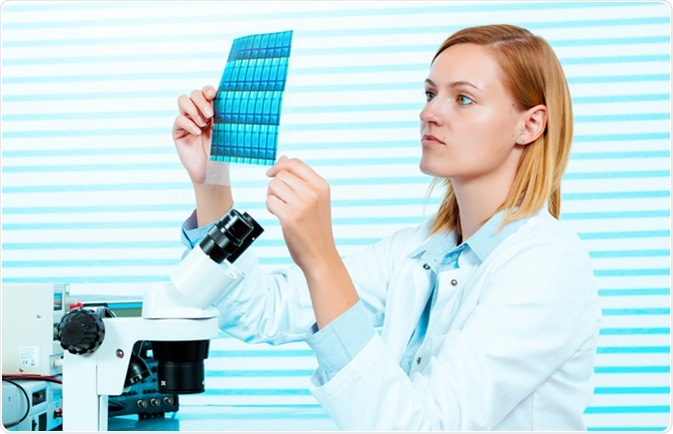Photolithography is one of the most important and easiest methods of microfabrication, and is used to create detailed patterns in a material. In this method, a shape or pattern can be etched through selective exposure of a light sensitive polymer to ultraviolet light.

Silicon wafers production, photolithography. Image Credit: Science Photo / Shutterstock
Process of Photolithography
Substrate materials such as silicone or glass are coated with photoresist, a light sensitive material that loses its resistance or susceptibility to attack by a solvent when exposed to light.
A photomask bearing opaque and transparent regions in the desired pattern is used to selectively illuminate the photoresist, leaving regions of photoresist covered by transparent photomask exposed. The opaque region is often made from chrome.
When using a positive photoresist, areas exposed to light break down and become soluble, whereas a negative resist becomes cross-linked and insoluble upon exposure to light. The resulting photoresist, in the desired pattern, is left on the substrate during etching or deposition of compounds, filling in the negative space around the photoresist.
The photoresist is then removed by sonication in an organic solvent. The protruding photoresist layer can be used as a mold to create microfluidic devices or stencils from polydimethylsiloxane.
Applications of Photolithography
Producing printed circuit boards
Photolithography is the most common method for producing printed circuit boards and microprocessors. A silicone wafer coated with an oxide layer is prepared with photoresist polymer and following the removal of the desired areas of photoresist through exposure to light, chemical agents are used to remove the oxide layer that are not protected by photoresist.
Microfabricating materials
Photolithography is gaining attention to microfabricate materials for a variety of applications within the life sciences. At the micro scale, fluids behave unfamiliarly, flowing without turbulence and mixing by diffusion alone. Microfabricated liquid pumps, valves, filters, and mixers that can handle fluids in this unusual state are created through photolithography.
Manipulating biomolecules
Microfabricated devices are used to manipulate biomolecules in genomics applications, and can be used to manipulate living viable cells, allowing examination of sub-cellular components. Small electrodes within the device create non-uniform electric fields manipulate large molecules or cells, aided by the small size of the device as the electric fields dissipate rapidly over distance, and a lower voltage can be used to power them on a small scale.
Microfabricated blood pressure sensors
Microfabricated blood pressure sensors are currently used in routine clinical practice, with several other types of biosensors coming into prevalence in the field. Again, a massive advantage of such devices is their size, allowing normally cumbersome equipment such as flow cytometers to be used.
The larger surface to volume ratio conferred by the size of microfabricated devices improves the ability to dissipate heat, allows for the analysis of small sample volumes, and provides a high-throughput platform.
However, microfluidic devices created using photolithography often have long development times and must be manufactured in a clean room, and thus, conventional machining is often a more viable option.
Photolithography: Step by step
Further Reading
Last Updated: Oct 28, 2018